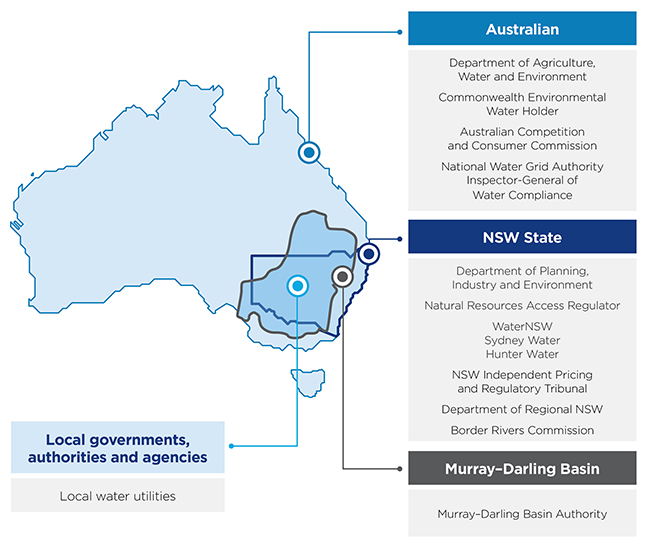Water sharing plans are statutory plans made under the NSW Water Management Act 2000. The 10-year plans set the priorities and rules for sharing surface water and groundwater between environmental and extractive needs, and between different types of extractive use for towns, domestic and stock and Native Title use, and other industrial and agricultural uses. They create certainty for water users by:
- defining sustainable limits on surface and groundwater use to enable supply reliability, downstream sharing and environmental outcomes
- protecting water for the environment, basic landholder rights and cultural needs
- providing secure, legal and tradeable water access rights to boost investment confidence.
Water licences set out how much, where and when water can be taken by licence holders. Different licence types cover different water uses and have different levels of security. Water sharing plans also set the rules for water trading - the buying and selling of water licences and annual water allocations.
In most parts of NSW, the available water is fully committed. For many people, purchasing water entitlements or allocations in the market is the primary way to secure the water they need. Water trading drives more efficient water use, increases economic productivity and helps to optimise use of water for the environment.
In the Murray-Darling Basin, which covers 75% of NSW west of the Great Dividing Range, the Murray-Darling Basin Agreement shares the available water in the River Murray system between NSW, Victoria and South Australia. This Agreement, together with water resource plans accredited under the Commonwealth Basin Plan 2012 and the NSW water sharing plans, limits the amount of water available to be allocated for use from NSW.
During normal operations, the highest priority for water sharing is the environment, followed by basic landholder rights (domestic and stock, Native Title and harvestable rights). During extreme events, such as prolonged droughts, the priority changes. Critical human water needs and essential town water services (authorised by an access licence) become the highest priority, followed by the environment. In the Murray- Darling Basin, the NSW Extreme Events Policy and regional incident response guides come into effect.
Priority | Normal circumstances | Extreme events |
|---|---|---|
Highest |
|
|
High to Low |
|
|
|
| |
|
| |
|
|
This change in priorities is triggered when a water sharing plan (or part of a plan) is suspended. The aim is to operate within the plan rules for as long as possible because the plan provides certainty for all users of these water sources. In light of the experience from the recent drought, we now have an opportunity to consider whether these triggers need to be reviewed.
The NSW water sector
Responsibility for water management in NSW is shared between Commonwealth, State and local governments, authorities and agencies (Figure 13). A number of inter-jurisdictional bodies, independent statutory bodies and corporations also play roles in managing water resources and providing advice to governments. Effective planning and delivery of water security solutions relies on cooperation and coordination between all of these organisations.

Note: Department of Planning, Industry and Environment cluster includes key agencies including the Environment Protection Authority, the Office of Local Government and Dam Safety NSW.
Figure 14 shows the roles and responsibilities for managing water at a state level. Further details of the water management framework in NSW are available at the Water in NSW webpage.
Roles and responsibilities | Water policy, |
|
|
|---|---|---|---|
Administration of |
|
| |
Distribution of |
|
| |
Water pricing |
|
| |
Monitoring, |
|
| |
Flood |
|
| |
Drought |
|
|
* Organisations that do water supply as well as wastewater
Reforms to the water sector
The NSW Government has recently made changes to improve strategic planning, delivery of infrastructure and operational performance across the water sector. The reforms improve coordination across the sector, enhance the strategic oversight of major investment decisions and assign explicit accountabilities for actions to address risks.
The Water Sector Leadership Group has been established, consisting of department's Water Group, NSW Treasury, Sydney Water, Hunter Water and WaterNSW. This group is leading improved coordination across the government-owned and managed water sector to put water customers and communities at the centre of everything we do.
WaterNSW will strengthen its role as a dedicated regional customer-focused organisation that supports water users and councils in the regions. To reduce the risk to regional towns, $4.9 million has been allocated to support a Town Water Risk Reduction Program. This voluntary program will give local water utilities and councils more levers to support regional coordination, address skills gaps, access the expertise of the water sector and improve the regulatory framework, as well as provide new options to deliver and finance town water infrastructure.
The reforms will also ensure that responsibilities for planning for Sydney’s future water supply are clear, with Sydney Water assigned the critical role of planning future supply augmentation for Greater Sydney to support the delivery of the Greater Sydney Water Strategy.
Water Infrastructure NSW has been established within the department to improve the governance and oversight of water infrastructure planning and investment.
These reforms are expected to lead to significant improvements in organisational arrangements that support improved service delivery and water security for regional towns and communities, drive greater innovation in the water sector and provide leadership in exploring and delivering solutions to address water security risks and diversify water supplies.